Photographing historical landmarks in Egypt requires tough decisions—starting with what to pack. My bag is ready, but weight is a problem. I’m headed along the Nile River from Cairo to Abu Simbel with the goal of capturing Egypt’s iconic landmarks through my lens. But the plane’s strict weight limits mean I can’t take everything I want.
Now comes the hard part. Do I ditch clothing and smell? Do I leave a few camera essentials behind? Maybe no computer? Hmm… Staring at my bags on the floor, I know the answer. I don’t want to admit it, but I have to. Laughing, I accept my reality and say to myself: Well, I’m just going to smell bad while I am photographing Egypt.
By Guest Contributor Dalton Johnson
What You’ll Learn in This Post:
- How to photograph historical landmarks in Egypt from Cairo to Abu Simbel
- Essential travel photography gear for harsh environments and museum interiors
- Tips for shooting iconic sites like the Pyramids, the Sphinx, and ancient temples
- Techniques for low-light photography inside tombs and crowded museums
- How to balance capturing images with fully experiencing each location
Travel Photography Gear Essentials: Why These Two Lenses Make All the Difference
Unloading my extra clothing, I tuck my best travel photography gear into my luggage and carry-on. One camera body, my go-to travel lenses, a handful of memory cards, some extra batteries, a cleaning kit, a computer, and a hard drive to back up the images at the end of every day.
No matter how many times I fly with my travel photography gear, I’m always a bit paranoid—so I keep my Sony camera body, Tamron 17-28mm F2.8, and Tamron 28-200mm F2.8-5.6 with me in my carry-on.
Tamron 17-28mm F/2.8 Di III RXD (Wide-Angle Zoom):
- Ideal for capturing vast landscapes, temples, and tight museum interiors
- Lightweight and compact, perfect for travel
- Fast f/2.8 aperture helps in low-light conditions (like tombs and museums)
- Sharp edge-to-edge for architectural details
Tamron 28-200mm F/2.8-5.6 Di III RXD (All-in-One Travel Zoom):
- Covers wide to telephoto, minimizing lens swaps
- Great for capturing distant subjects like details on pyramids or candid street scenes
- Versatile for shooting portraits, landscapes, and architecture
- Lightweight for a superzoom, saving space and weight in your pack
Together, these two lenses allow me to travel light without sacrificing image quality or creative range—something I’ve come to value deeply when working in unpredictable conditions across Egypt.
Essential Travel Photography Gear Checklist for Egypt
Here’s the streamlined kit I packed for photographing historical landmarks across Egypt:
- Sony Camera Body – Compact, mirrorless, reliable in harsh conditions
- Tamron 17-28mm F/2.8 – Lightweight wide-angle zoom
- Tamron 28-200mm F/2.8-5.6 – Versatile all-in-one travel zoom
- Memory Cards – Multiple, high-speed cards for backups
- Extra Batteries – Long shoot days require extras
- Lens Cleaning Kit – Sand, dust, and fingerprints are constant
- Laptop & Hard Drive – For daily image backups and review
Three flights and thirty-seven hours later, I’m in Cairo. It’s 11:52 PM. The camera gear made it, thankfully. My local guide is at the airport waiting for me with a smile. If there is one thing I have learned from traveling around the world for photography, it’s the need to have a local with you. For this trip, I have paired with Abercrombie and Kent to have access to an Egyptologist to help make sense of everything I am shooting. Everyone has a specialty, mine is the camera, so pairing with Mohamed Rehim to explain the significance of a structure, translate hieroglyphics, and help navigate the cultural barrier is a symbiotic relationship.
Now, to the hotel, so I can catch a few hours of sleep, the next nine days photographing Nile River historical sites are going to demand long hours.
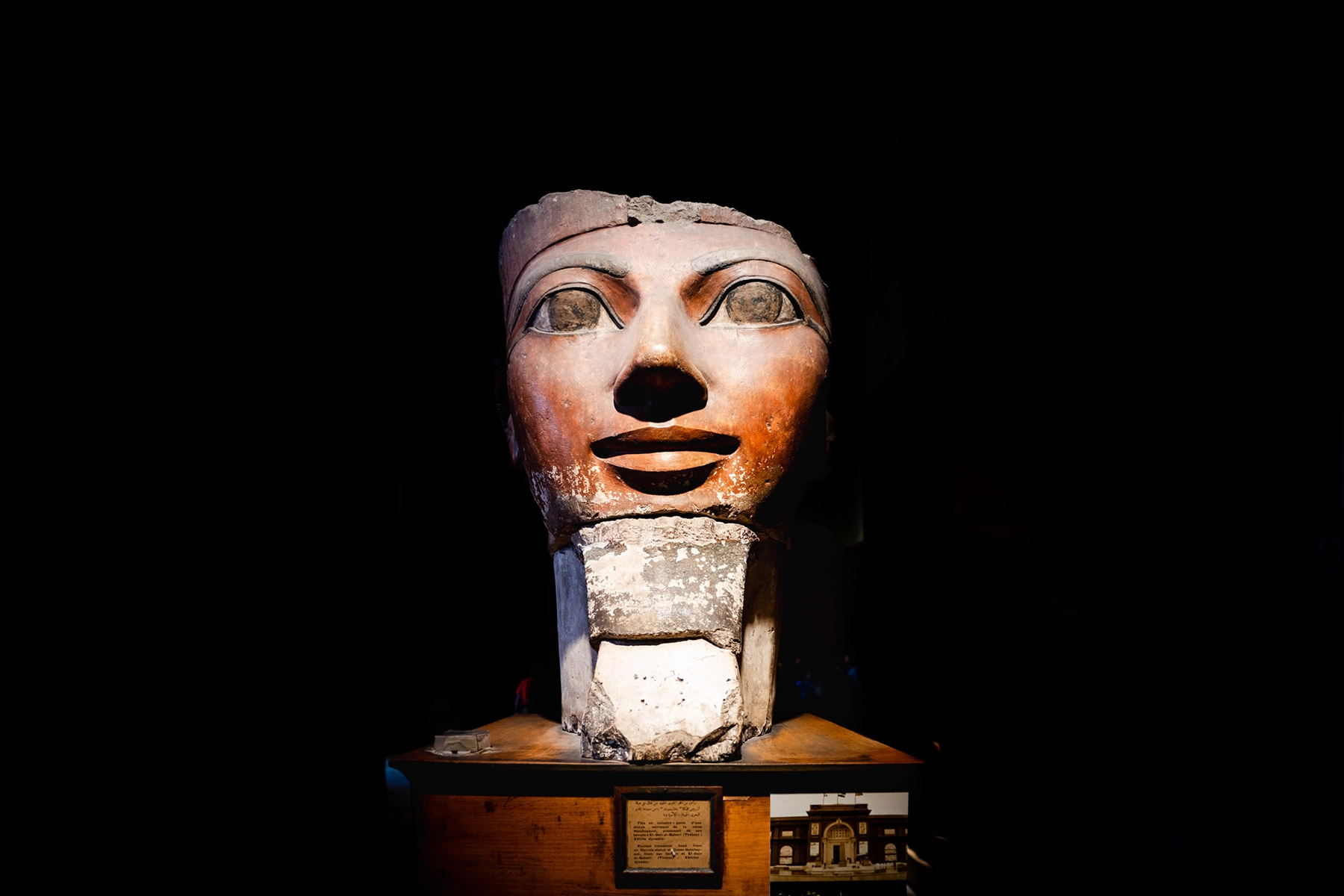
Photography Tips for Egypt’s Museums: Lighting, Settings & Storytelling
I can’t tell you how many times I have wandered through a museum, mostly lost because I don’t understand the significance of what I am looking at, but with Rehim at my side, he brought to life each exhibit. Making our way through the Egyptian Museum and the recently opened Grand Egyptian Museum, the foundation for the rest of the trip was laid. While photographing inside a museum isn’t always allowed, it is for most Egyptian museums.
Here are tips for photographing inside museums.
- First, know what you are photographing. My educational indoctrination to all things Egyptian began at our first museum. While I have always been fascinated by Ancient Egypt, my study of the area stopped in middle school outside of the occasional news article and T.V. show. So, having Mohamed showcase the small details and connecting recent discoveries to what I was seeing started to paint a picture of what was to come throughout this trip.
- Second, photographing artifacts requires mastery of your camera settings. My first opportunity to photograph Egyptian artifacts was inside the Egyptian Museum in Cairo. One of the best parts of visiting this museum first was the lighting in the exhibits and photographing artifacts is allowed. The exhibit curators utilize the room’s lighting to draw your eye to the important parts of an exhibit. This creates a unique opportunity, when avoiding crowds in photography, to master your camera settings and achieve studio-quality images.
- Use a wide aperture in low light. One low light photography technique I utilized with both travel lenses I packed was leaning into a wide-open aperture of f/2.8. This low light photography trick gave me enough light that I could keep the subject bright and in focus but blur out the background. Giving the look that I was photographing an Egyptian artifact in a studio. The good news is if you don’t nail exposure perfectly in camera, you can always drop the black’s and shadow’s in your edits to amplify the look.
- Select a wide-angle setting. Since many of the artifacts dwarf the rooms that they reside in, I found myself using the Tamron 17-28mm lens most often in Egypt’s museums.
- Quick Crowd Tip: Avoiding crowds in photography, especially public spaces like a museum, is a challenge, but if you have extra time, wait around for the crowds to move along. Another way to avoid crowds in travel photography is to arrive right at opening or stay until closing.
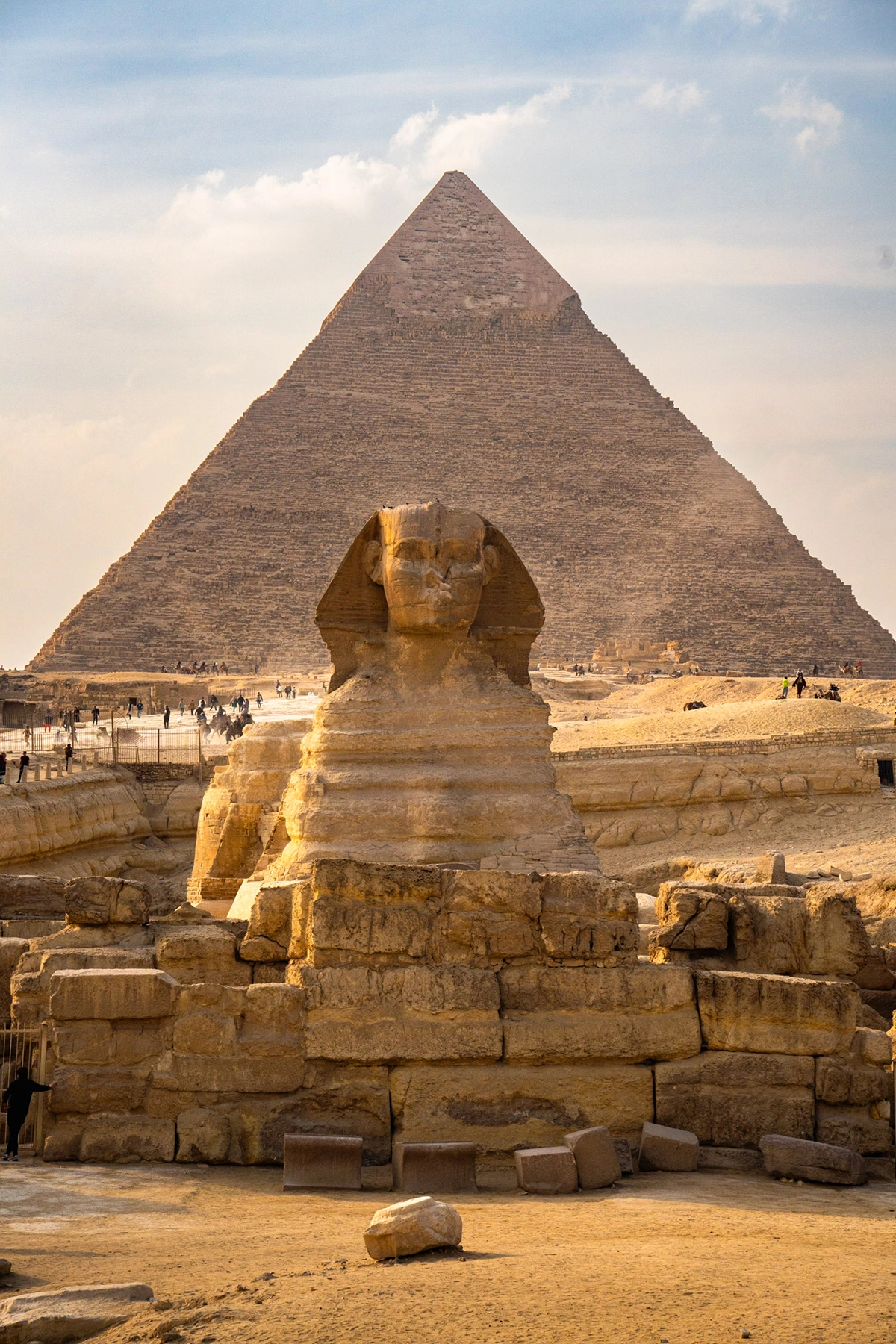
How to Photograph the Great Pyramids of Giza and the Sphinx
If there are two things for certain while traveling in Egypt, it is sand and heat. So, early mornings are the norm, and relying on the weather resistance of your camera lenses is especially important while out shooting in the harsh landscape.
Get to your location early.
Waking up around 5 AM to get a good start when photographing the Pyramids of Giza was essential. Did you know there are 118 discovered Egyptian pyramids? If not, you and I were in the same boat until this trip. So, the grouping of three towering pyramids and the giant sphinx is really known as the Great Pyramids of Giza, which are all located on a single plateau near Cairo, Egypt.
If you are anything like me when traveling Egypt with a camera, the pyramids are a must see. But how do you photograph the pyramids? This land area is massive, requiring buses, or camels, to move around the plateau. You could walk, but it is not practical. With limited time, the distance creates an issue for photographers because you can’t be in two places at once. So, you have to choose.
Here’s how we planned our photography day for the pyramids:
- Morning. Arriving early and entering the historical area from the north entrance, we took in the stunning views while Mohamed explained recent discoveries about how the pyramids were built and the misconception that slavery was used to build the pyramids. Opting first to go inside the largest of the pyramids, The Great Pyramid of Giza built for Khufu in 2543 B.C., because this experience ends at noon and takes a few hours.
Quick Equipment Note: Photography with mirrorless, or DSLR cameras, are not allowed inside the pyramid without special permits, but you can take images with your phone. Crawling through the internal passages will leave you sweating from the heat and dumbfounded by the ingenuity of the building.
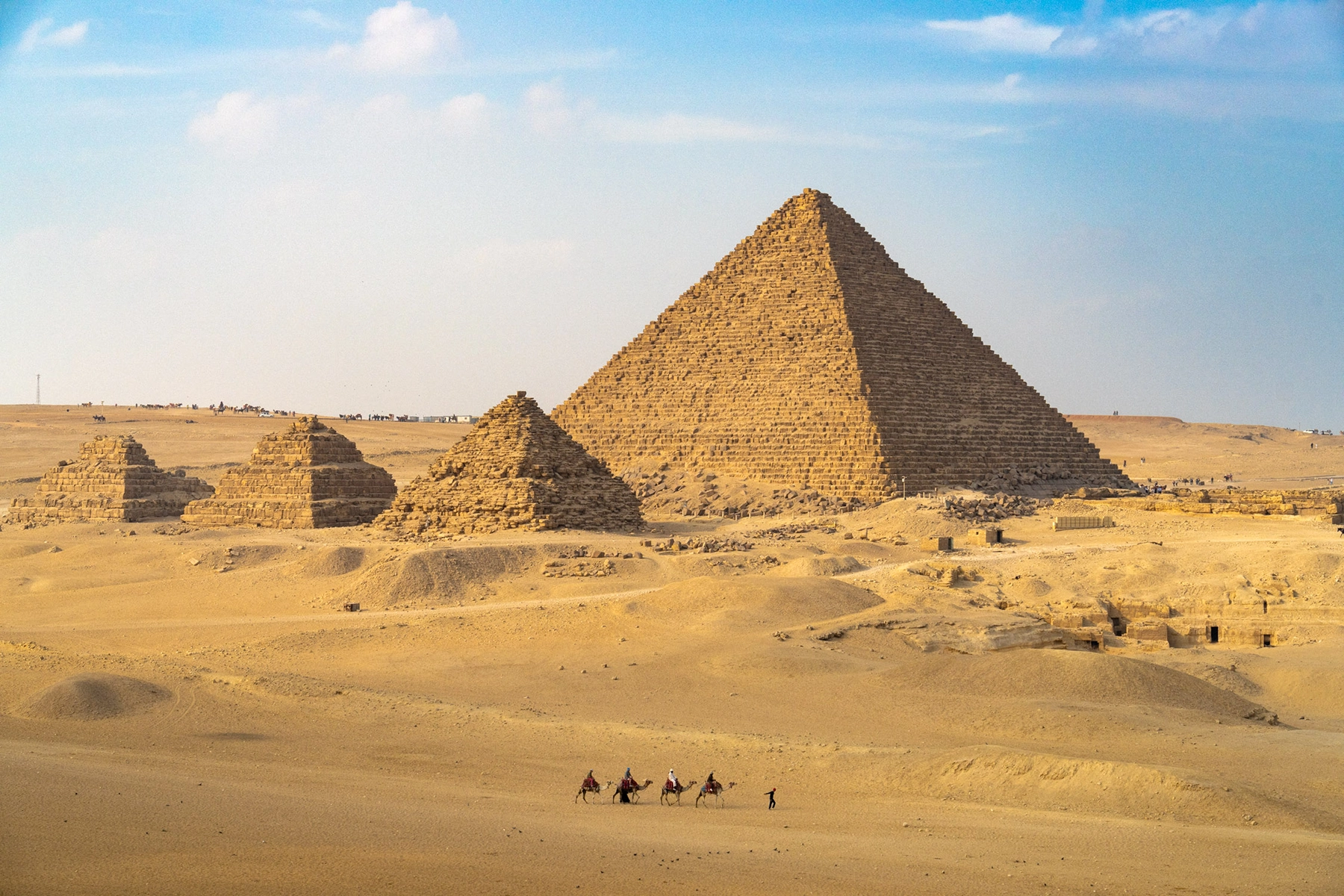
- Head to the southern border of the Giza Plateau, one of the best photo spots in Egypt, for a panoramic view of The Great Pyramids of Giza and a quick bite to eat so we can keep moving around and photographing the plateau. From the southern aspect, the scale of the pyramids comes to life as you will see people and camels dwarfed at the base of the pyramids. My favorite part of this view is seeing the smaller pyramids, built for the wives and mothers of the pharaohs, that almost nobody mentions.
- As the sun dipped along the horizon, we made our way to the eastern side of the plateau, getting our first glimpse of the Great Sphinx. It was here that the resident Egyptologist, Mohamed Rehim, dove into the unsolved mysteries of the Sphinx, the lack of a second Sphinx, and a few additional unsolved mysteries around the pyramids.
With this pyramid itinerary, you miss out on the sunrise light with the alignment of the Great Sphinx and the Pyramid of Khafre. When you visit the pyramids yourself, you will need to decide what is important to you and prioritize that. For me, this worked. I might have tried to slip a golden hour travel photography shot, or two, of the alignment, but other than that, this itinerary worked.
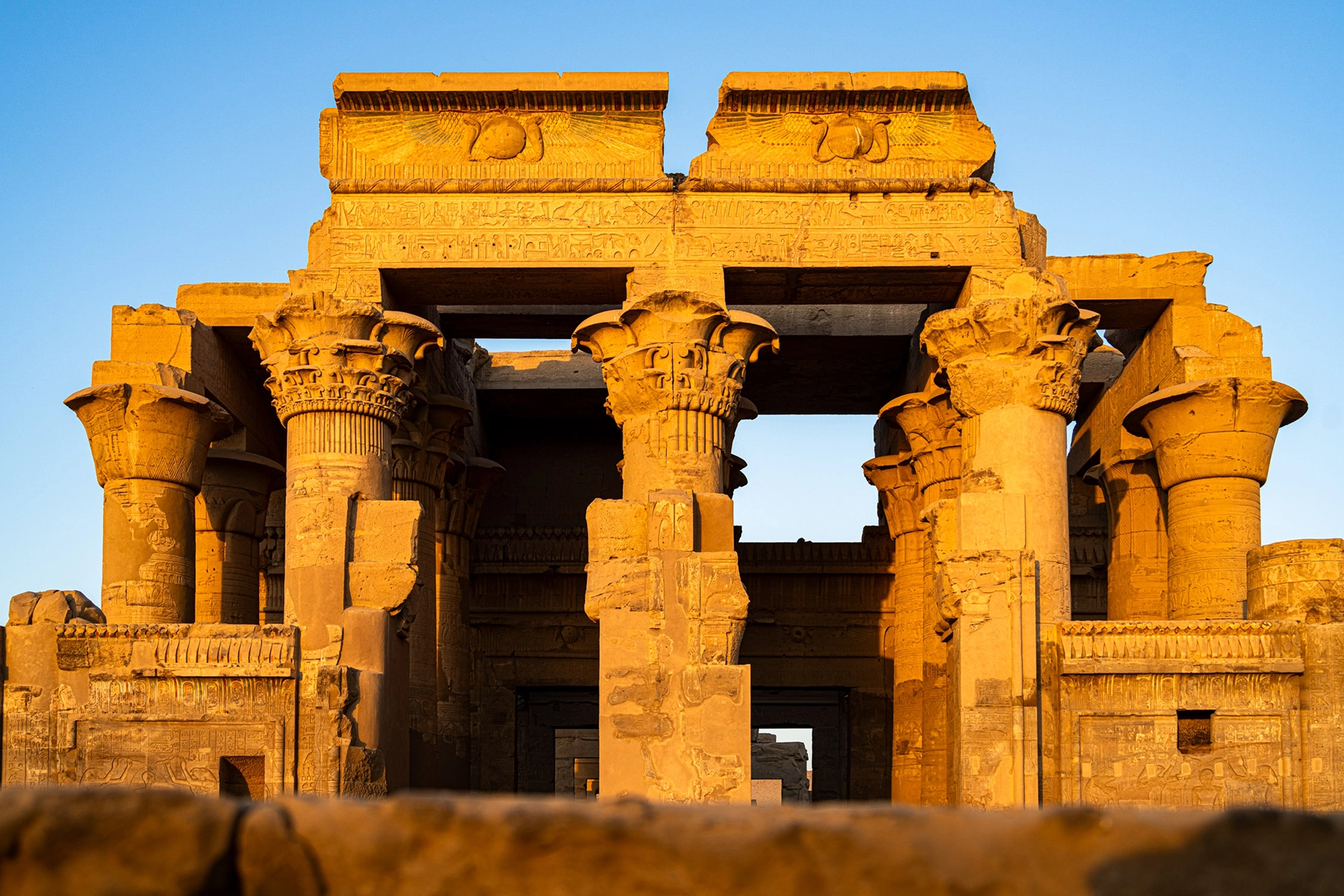
Photographing Ancient Temples in Egypt: Balancing Light and Travel Experience
When traveling Egypt with a camera, there is a balance between photography and travel experiences so that you do not get lost in the moment or forget to shoot. As a full-time working photographer since 2017, focused on travel storytelling photography, this balance still does not come easy.
With deliverables required upon return from a project, I tend to overshoot so I can have options in the editing bay that land in the trash can. However, that approach takes away from the experience and ability to learn. Much like the inability to be in two places at once, our attention can only be focused on one thing at a time. So, when traveling to experience a new place and capture images, you have to pick and choose where to direct your focus. This was most notable while visiting Nile River historical sites.
Arriving mid-day in the beating sun at Abu Simbal for the Temples of Ramses II and Queen Nefertari, the Philae Temple in Aswan, the Temple of Horus in Edfu, and the Temple of Hatshepsut in Luxor, my focus was on finding the small pocket of light to photograph and the historical importance of these locations. However, when sunrise and sunset opportunities arrived at the Luxor Temple, Kom Ombo, and Karnak, my focus was purely on photographing ancient ruins.
Finding and accepting this balance allows me to take stunning photographs while enjoying and learning from the opportunity to visit these ancient sites. I suggest you try to find what works for you by understanding what you gain and lose when you bring your camera out.
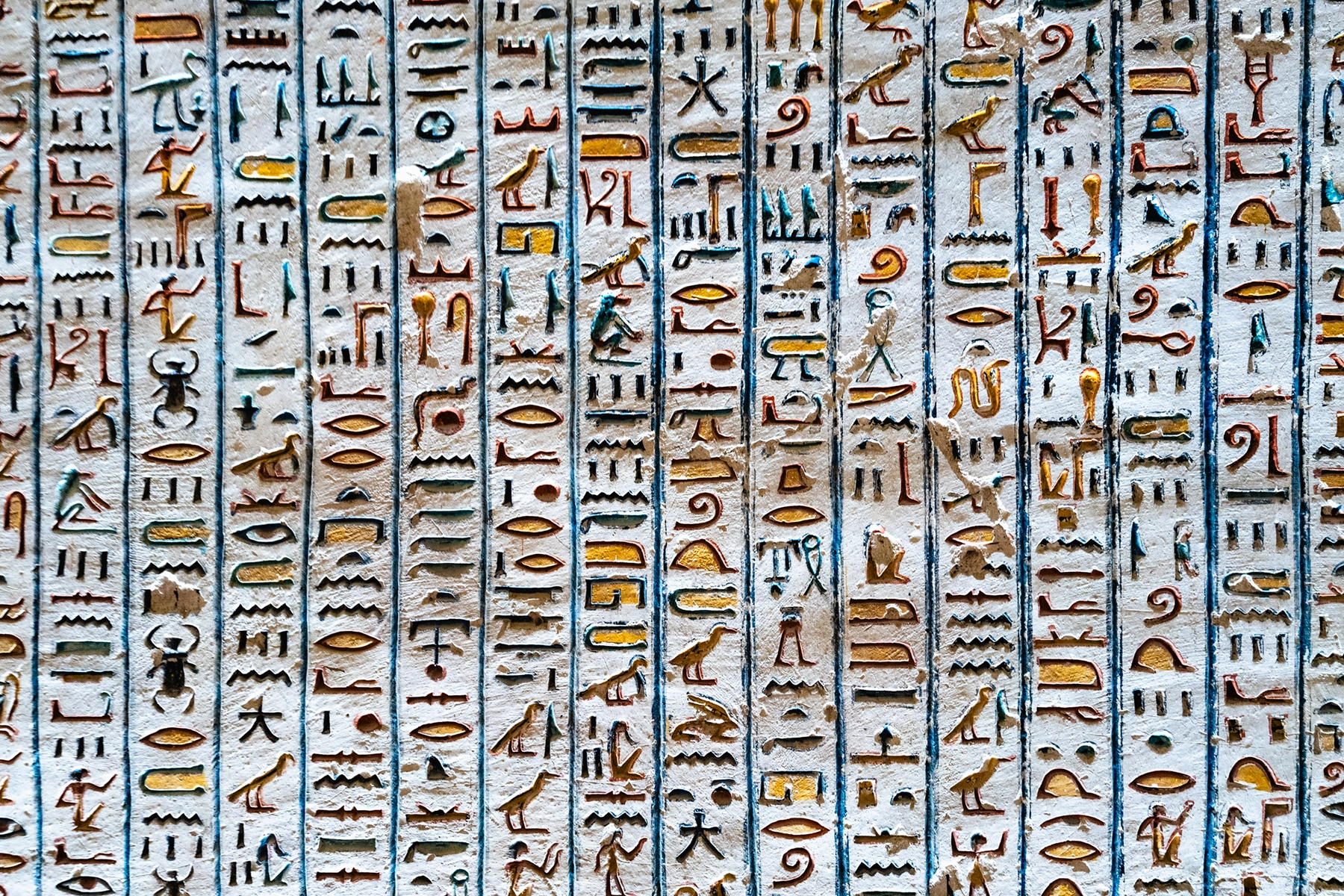
Luxor Photography Tips: Capturing Detail in the Valley of the Kings and Queens
Floor to ceiling and wall to wall the tombs of the kings and queens are carved and painted. The Egyptian tombs, dating back to 1539 – 1075 B.C., are still a modern marvel despite being more than 3,000 years old. The attention to detail had an approval process starting with blueprints, miniature replicas, sketches on the wall by apprentices, checked by master painters, and finally painted by the master painters in a single color.
So, when you wander into a tomb within the Valley of the Kings, or the Valley of the Queens, with your camera, you are walking into a masterpiece. It is easy to point your camera and shoot, but I found necessity in using the Tamron 28-200 zoom lens to capture the grand scale and beauty of these massive tombs to the detail smaller than the tip of my finger.
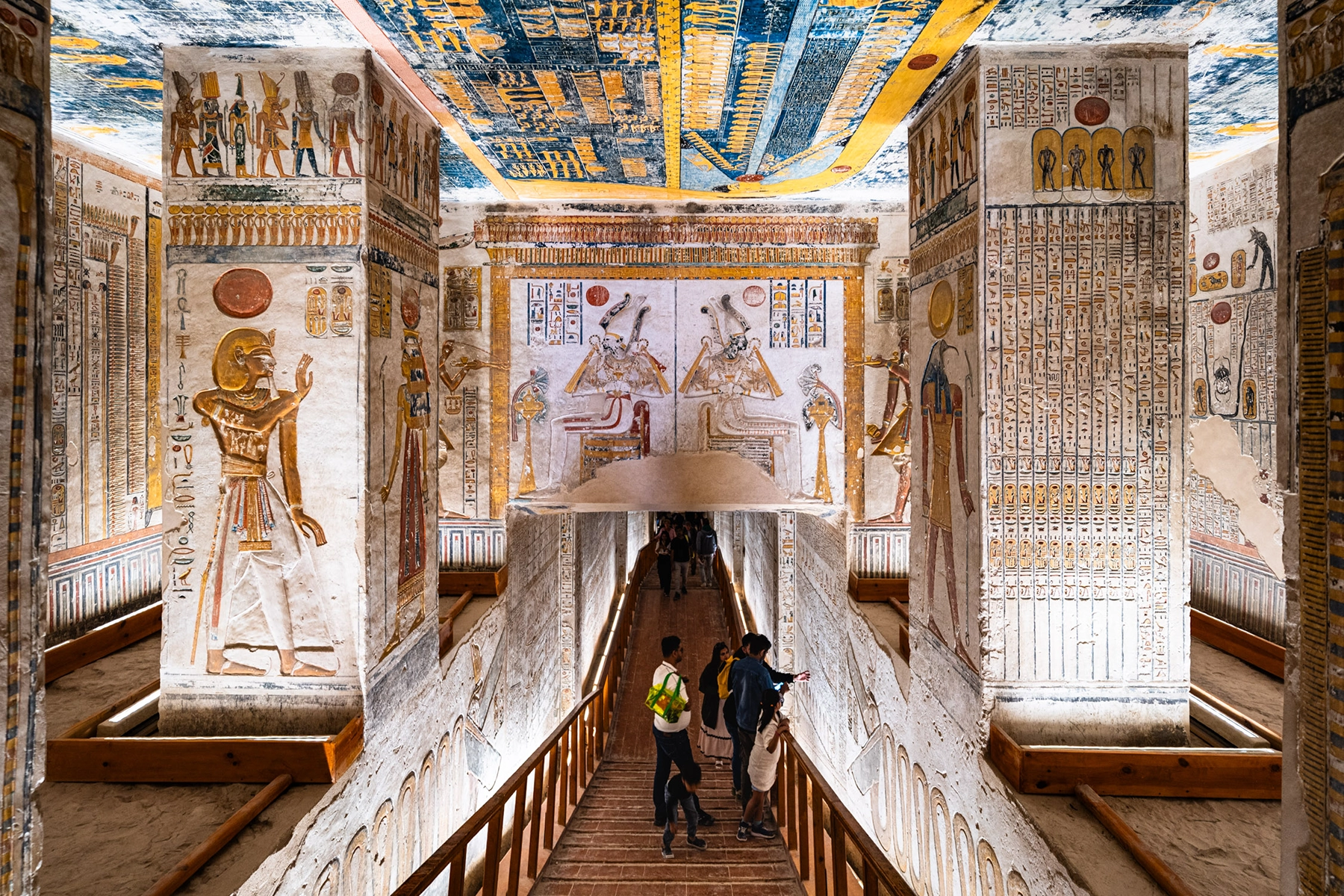
Inside these tombs, there are several people about and it is dimly lit, so having a zoom lens that opens up to f/2.8 was paramount for capturing crisp images. Any aperture smaller than f/5.6 would not have let in enough light inside of the tombs.
To counter this, you can use a low light photography technique like using a slow shutter speed around 1/20th of a second. Just be careful of moving and blurring the image. Also, having a lens that is mobile was helpful because some of the popular tombs, like King Tutankhamun’s, were shoulder to shoulder, limiting mobility.
While time isn’t always on your side, when you see a shot, take the opportunity to wait for a shooting window and avoid the crowds. In other words, if the tomb is full right now, wait a few minutes, most likely people will clear away, reducing the crowds, and you can capture that wide shot. However, if you are taking tight shots, say something in the range of 85mm, or tighter, be willing to step close and make some space for yourself to capture the image you would like to capture.
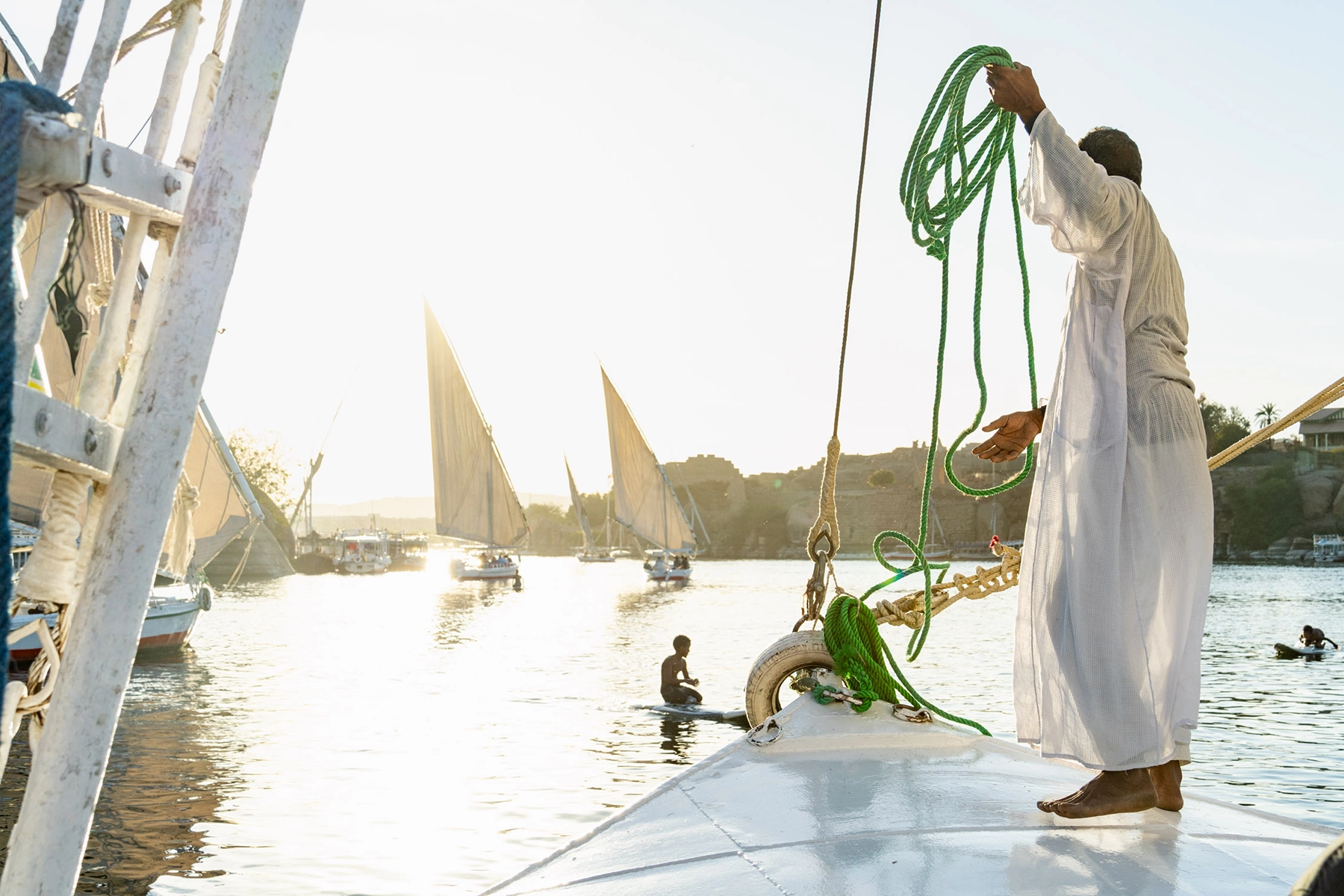
Sharing Your Egypt Travel Photography: Capturing Connection and Culture
Ten days focused on travel photography in Egypt is not much time and that is the beauty of travel. When visiting a new location, I find there is a mindset shift as I connect with the history, the people, the landscape, and the present state of the location.
The reminder that there is beauty in all aspects of life, especially when connecting with a place, like the Egyptian Nile, through a medium like photography is a gift that lasts. While snapping photographs can pull you out of the moment, when I board my plane home and sit back in your editing room at home, you’ll smile at the memories your photographs conjure. You might get mad at yourself as well for botching the focus, or exposure, but that is part of learning the craft of photography.
For myself, photography is more than snapping images. It’s how I connect. Connecting with locals through photography allows me to become an ambassador of the area and encourages me to stay connected with the people and places I visit. Now that I have been to Egypt, I try to keep in touch with people I have met there, like Mohamed.
I show my travel photographs, like in this article, hoping to inspire you to travel with a camera. Each time I share images and stories from the trip, I reconnect with the places I’ve been and the people I met along the way. My hope is that you take photographs you want to share with your friends, your family, and maybe the world.
About the Author
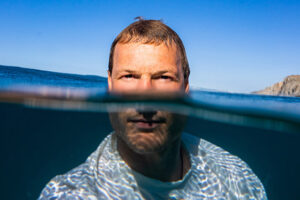
Dalton Johnson is invested in mastering the craft of storytelling through the mediums of photography, writing, and video. Specializing in adventure travel, Dalton creates content for experiential travel brands. These brands are based around the world in remote places and hidden escapes within major metropolitan cities. He has been on assignment on every continent and has delivered over 160 campaigns in his 10 years of content creation in the adventure travel industry. Working for clients like Ford, Four Seasons, Rivian, Men’s Journal, Stillpoint Lodge, B.F. Goodrich, Turneffe Island Resort, Nike, Rancho Santana Nicaragua, Patagonia, Polaris Adventures, Tamron Lenses, and many more, he is no stranger to bringing a project to life. In the end, Dalton’s vast body of work has one thing in common: storytelling.
Instagram: @storiesbydalton
Website: https://dalton-johnson.com/
